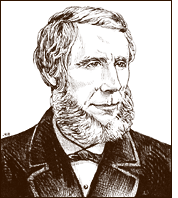

by Steve Graham • October 8, 1999  John Tyndall was a man of science—draftsman, surveyor, physics professor, mathematician, geologist, atmospheric scientist, public lecturer, and mountaineer. Throughout the course of his Irish and later, English life, he was able to express his thoughts in a manner none had seen or heard before. His ability to paint mental pictures for his audience enabled him to disseminate a popular knowledge of physical science that had not previously existed. Tyndall's original research on the radiative properties of gases as well as his work with other top scientists of his era opened up new fields of science and laid the groundwork for future scientific enterprises. In January 1859, Tyndall began studying the radiative properties of various gases. Part of his experimentation included the construction of the first ratio spectrophotometer, which he used to measure the absorptive powers of gases such as water vapor, "carbonic acid" (now known as carbon dioxide), ozone, and hydrocarbons. Among his most important discoveries were the vast differences in the abilities of "perfectly colorless and invisible gases and vapors" to absorb and transmit radiant heat. He noted that oxygen, nitrogen, and hydrogen are almost transparent to radiant heat while other gases are quite opaque. Tyndall's experiments also showed that molecules of water vapor, carbon dioxide, and ozone are the best absorbers of heat radiation, and that even in small quantities, these gases absorb much more strongly than the atmosphere itself. He concluded that among the constituents of the atmosphere, water vapor is the strongest absorber of radiant heat and is therefore the most important gas controlling Earth's surface temperature. He said, without water vapor, the Earth's surface would be "held fast in the iron grip of frost." He later speculated on how fluctuations in water vapor and carbon dioxide could be related to climate change.
Tyndall related his radiation studies to minimum nighttime temperatures and the formation of dew, correctly noting that dew and frost are caused by a loss of heat through radiative processes. He even considered London as a "heat island," meaning he thought that the city was warmer than its surrounding areas. Over the course of his life, John Tyndall published numerous papers and essays on his scientific discoveries, as well as literature, religion, mountaineering, and travel. His accomplishments led him to receive five honorary doctorates and become a respected member of thirty-five scientific societies. next: Links and References |
On the Shoulders of Giants
Images
| ||